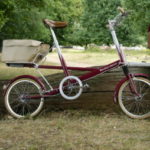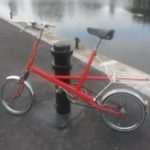This group is open to all registered members of the site.
Specifications / sizes for Mk1 / 1965
- This topic has 27 replies, 10 voices, and was last updated 9 years, 9 months ago by
 david james.
david james.
-
AuthorPosts
-
June 17, 2015 at 7:09 am #4716
 IanParticipant
IanParticipantCouple of books to get – The F frame by Tony Hadland and (if you can find it) The classic Moulton by Paul Grogan.
Bearings ⅛” for the forks ⅜” for the cranks I think. Take the old ones to a proper bicycle shop and they’ll have some suitable. 1″ seat post
Brompton wheels might be a problem (the front axle will be too narrow although you can bodge it to fit) re lace hubs with 28h alloy rims is common.
June 17, 2015 at 7:25 am #4717David
ParticipantHello Ian
Thanks for the reply and info – I think I’ll rebuild the rims if that is the case.
David
June 17, 2015 at 6:12 pm #4718Bruce
Participantbottom bracket ball bearings would be 1/4″ diameter.
Brompton aluminium rims are cheap enough and the hubs are not ‘difficult’ OLN dimensions on a Moulton.
cheers
June 17, 2015 at 7:53 pm #4719 david jamesParticipant
david jamesParticipant“proper bike shop” means not halfrauds!
June 18, 2015 at 5:04 am #4720 CLIVE FENNERParticipant
CLIVE FENNERParticipantBRUCE, OLN ?????
June 18, 2015 at 5:59 am #4721David
ParticipantThanks – I’m surprised I never got picked up on ‘power’ coating!
Re 1inch post – which in new money is 2.54 – Doesn’t fit. I guess I’ll get out the micrometer.D
June 18, 2015 at 4:26 pm #4722Bruce
ParticipantOLN = over lock nut dimension, i.e. width between dropouts.
cheers
June 18, 2015 at 7:24 pm #4723Bruce
Participantalso; my Mk1 accepts a 25.8mm seat pin and with a light ream would take a 26.0mm one I suspect.
cheers
June 20, 2015 at 6:24 pm #4724 Des GibbonsParticipantJune 20, 2015 at 9:27 pm #4725
Des GibbonsParticipantJune 20, 2015 at 9:27 pm #4725 david jamesParticipant
david jamesParticipantthe actual weight saving in an aluminium over steel rim is minimal,especially on such a small wheel, most of the weight is in the spokes and the hub, if it’s rusty beyond use change, otherwise no point
June 25, 2015 at 7:16 pm #4726Dave Minter
MemberThere is a good reason to use aluminium rims – if you want to actually stop in the rain.
June 25, 2015 at 7:37 pm #4727 david jamesParticipant
david jamesParticipanteveryone says that but i,ve been riding mine on steel rims for 3 months or so in rain as well and it doesn’t (to me) seem to be a problem, certainly on larger 26 inch wheels but the small wheels no, my theory is it takes one or two revolutions to clear the rain off which is no horizontal distance, obviously on larger wheels it will be
June 26, 2015 at 6:09 am #4728Dave Minter
MemberYou either have the only chrome steel rims that have a decent wet coefficient of friction or oil-lubricated aluminium rims. The difference in wet weather braking is stark.
June 26, 2015 at 3:39 pm #4729 david jamesParticipant
david jamesParticipanti suppose it’s personal preference, i’ve ridden bikes on steel rims since the 60’s and i’ve never had a problem.apart from the rust.new alloy rims for a brompton are 1.5mm thick on the rim and as we know alloy rims wear, especially on smaller wheels, i would be interested to know how long they last on a brompton
June 26, 2015 at 8:37 pm #4730 Les CrookMember
Les CrookMemberI rode steel rimmed wheels in my yoof, and only stopped once something less mobile had arrested my momentum. First time i rode ali rims in the wet I stopped about 5 yards short of where i had intended,
June 26, 2015 at 9:40 pm #4731 david jamesParticipant
david jamesParticipanti can only assume you were trying to emulate a “tour de france” rider in town! as i said i have no problem with stopping and in portsmouth it’s probably one of the most congested cities in the country with some of the worst taxi drivers, if i was to “upgrade” all my moultons with ally wheels it would cost me a small fortune, i was riding my south african built recently on a shopping expedition in rain and it behaved faultlessly if you apply both brakes simultaneously.also the wheels are original and 49 years old, all i need is a period saddle !
June 26, 2015 at 10:39 pm #4732William Poole
MemberThe first Norwegian manufactured Moultons are now exactly 50! years old and so are their original (340) alloy rims, which are still going strong with no brake wear!
Øglænd manufactured bicycles from that time, and before and later, were all fitted with alloy rims, but also hub/drum brakes to combat the harsh Northern weather and road conditions. This shows a lot about the advantages of the combination of alloy rims,which don’t rust, and hub brakes,which perform well in adverse weather condtions. Perhaps another reason still for the MoBiCo to look again at the future fitment of disc brakes on Moulton bicycles?!June 27, 2015 at 5:40 am #4733Dave Minter
MemberOh, I see. Braking on wet steel rims is fine, if you travel slow enough that you don’t need to use the brakes.
Aluminium Brompton and Moulton rims last 2-4 years in this household while ‘big wheel’ rims last 3-5 years. The durability difference matches the difference in circumference.
June 27, 2015 at 8:59 am #4734 david jamesParticipant
david jamesParticipanti do suspect the rims from the 60’s were made from a better material than the rims of today, i have a rigida brompton rim and it is made of the thinnest material they could get away with, even if it was 1mm thicker on the walls it would be acceptable. two big wheel bikes i have have drums and they have excellent performance wet or dry but i suspect discs are the way forward because of the weight saving. but the torque created on the forks may create a need for stronger forks.alloy wheels are a bugbear on cars as well in my opinion but for totally different reasons
June 28, 2015 at 10:27 am #4735Alexander Johnston
ParticipantI avoid any potential problems by not riding in the rain and slowing down if caught in an unexpected shower.
June 28, 2015 at 7:10 pm #4736 david jamesParticipant
david jamesParticipantit’s interesting googling “wear on alloy rims” there are stories of people being thrown off their bikes into the road when the rims split and pieces flying across the garage when they explode whilst being pumped up and brompton rims seem to wear particularly badly.i would suspect 90% of brompton owners are unaware of the problem
June 28, 2015 at 7:56 pm #4737Alexander Johnston
ParticipantIt happened to me once. The back rim imploded on my rigid Stumpjumper mountain bike.
Gave me the fright of my life.
Now I clean the rims and brake blocks after every ride in case a bit of grit has been picked up.
I try and ride the way I drive, braking as little as possible subject to safety considerations.June 28, 2015 at 8:25 pm #4738 david jamesParticipant
david jamesParticipanti’m going over to drum brakes on my non-moulton bikes, the price of hub brake hubs can be silly about 70 quid for a new sa and 150 for a sa 5 speed rear hub but you can pick them up cheap on ebay there was a bike recently for 45 quid with the above in 700c wheels on a buy it now deal.you can get a variety of bolt on brackets to fix to existing frames although i’m not sure how the moulton front and rear forks would cope but presumably ok with mk2 as they had them on norwegian models.with disc brakes it would seem you need an accurately welded on bracket to take the caliper, not impossible but difficult for an amateur cycle enthusiast (like me) i would imagine
June 29, 2015 at 12:39 pm #4739Bruce
Participanthub brakes are a pretty good idea really. It is a shame they are as heavy as they are though…. I’d advocate drums over discs in any case where there is any question about the strength of the frame/fork; the loadings into the frame are about x3 higher in a typical disc installation vs a typical drum installation. I don’t think either end of an F-frame would accept a disc brake without substantial modification to make sure it was strong enough.
I don’t think that it is at all easy to react the loads from any hub mounted brake into the suspension of a leading link fork BTW; any way you do it, the original way the suspension was designed to work will be altered (corrupted) entirely.
cheers
July 1, 2015 at 6:56 am #4740 IanParticipant
IanParticipantI’d do it like this.
-
AuthorPosts
- You must be logged in to reply to this topic.


